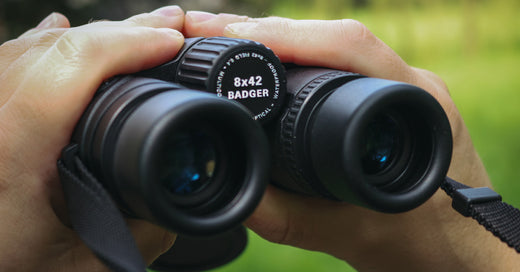There are many contributing factors to consider when choosing a pair of binoculars. This will vary from the weight of the binoculars to factors such as the type of prisms that they use. Each factor is important and will determine exactly which binoculars are the best fit for you. However, there are two key terms which are vital; magnification and objective lens.
Objective lens determines how much light the binoculars will allow in. With more room for light to enter the binoculars, the image quality will become much clearer and defined. Selecting a much larger objective lens will result in the highest possible image quality. However, this will impact the weight and size of the binoculars.
The magnification of binoculars is the value of how large objects will appear through the binoculars. For example, the majority of binoculars provide a 8x or 10x magnification zoom. Viewing an object that is 100 metres away through a 10x zoom will make this appear only 10 metres away. Therefore, a higher magnification value will result in a much closer zoom.
It is important to note that a higher magnification is not always best. A higher magnification power will result in a much narrower field of view. This will limit the scope of what you can see through the binoculars. This is why it is vital to find the right balance with the binoculars that you choose.
Which Magnification Is Best?
As previously mentioned, a higher magnification is not always the right choice. When looking through the binoculars, the magnification also amplifies the movements of your hands. This can make it difficult to maintain steady viewing and will distort the overall image quality. Consider what activities you will be using the binoculars for and the environment that you are operating in.
Both the 8x and 10x magnification binoculars will be perfectly suitable for activities like birdwatching. The zoom available on both binoculars will be effective in examining any birds that you can see. However, the two magnifications will change how the binoculars actually operate due to overall FOV. Selecting binoculars that offer a magnification power of 10 will narrow the overall FOV. This can make locating and tracking targets much more difficult in general.

Viking Kestrel 8x42 Binoculars
In comparison, binoculars with a magnification of 8 are generally more accessible and therefore more suitable for new users. The wider FOV makes tracking targets much easier - especially when you are brand new to birdwatching. In addition to this, image quality is almost identical with binoculars with higher magnification values. Therefore, you are not losing out by selecting a pair of binoculars that offers less zoom.
Does this automatically make binoculars with a magnification power of 8 the best option? Well, not necessarily. It really comes down to the activities that you are doing and the environment that you are working in. Both magnification powers will provide excellent results and image quality will be crystal-clear. Those that want to get the closest possible observation should consider the 10x magnification zoom. If you are just beginning your birdwatching journey, then the 8x zoom will provide everything that you need.
Exit Pupil: Why Is This Important?
The final point to consider when looking at the magnification of binoculars is the Exit Pupil. This is what dictates how bright images will appear when viewing them through the binoculars. A higher number will indicate better viewing in low-light environments. For example, in low-light situations an exit pupil of 5mm would be greatly beneficial. The exit pupil will also impact on image clarity if the binoculars were to move or shake when held. With everything considered, how does magnification fit in to this?
Dividing the magnification by the objective lens diameter will determine the value of the Exit Pupil. Binoculars that offer an 8x magnification and an objective lens diameter of 32 will provide an Exit Pupil of 4mm. This would provide an extremely clear image even in low-light conditions.
Binoculars with a lower magnification power and objective lens will not take in as much light. Therefore, these would not be suitable for use in all environments and light conditions. Finding the correct balance for this will result in the highest possible image quality.
Verdict
Determining which magnification power can be tricky. There are many independent factors to consider that will define which magnification is best for you. Both the 8x and 10x magnification zoom will provide great results and will be suitable for all occasions. Whether this is for birdwatching or general observation, this magnification range will be perfect for this.
For those that are just starting out, a magnification power of 8 is ideal. This will provide you with the zoom necessary for all activities and provides a wide FOV. These level of magnification will also result in less distortion if the binoculars were to move during use.
However, for those that want the ability to have a more detailed examination, a magnification power of 10 is perfect. This is suitable for all users though will require a steady hand to ensure you receive the best results. In addition to this, the reduction in FOV makes this less accessible than binoculars with a smaller magnification. If you are unable to hold the binoculars steady, then you are likely best opting for a smaller magnification.
Read More: Top 10 Best Binoculars - 2025



